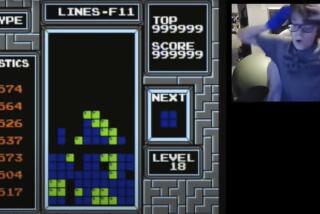Still Falling for ‘Tetris’
- Share via
One of the first games played on the personal computer also happens to be one of the most enduring games of all time.
Introduced in 1984, “Tetris” has sold 50 million licensed copies. New versions of the game are being released by THQ Inc. for next-generation consoles and, of course, the PC.
What gives the game such longevity?
“Tetris” is easy to play but difficult to master, taunting players for hours at a time.
Despite changes in the game’s graphics, the core game play is essentially identical to the original version created by Alexey Pajitnov to run on a Russian computer on a black and white screen using only text-based shapes. Pajitnov was a scientist with the Computer Center of the Academy of Sciences in Moscow when he began making puzzle games as a way to test new computers.
His first game involved seven shapes built from four square blocks, giving rise to the name “Tetris” that comes from the Greek word tetra, meaning four. The shapes fall from the top of the screen--players rotate them as they fall to fit with the changing grid, below.
Although the game has achieved spectacular sales, Pajitnov did not begin receiving royalties until 1996. Before that, the money went to the Academy, his former employer, and the Soviet Ministry of Commerce. To remedy that, Pajitnov and Henk Rogers established a company, now called Blue Planet Software Inc., to develop and license all “Tetris”-related products.
These days, Pajitnov, 46, is designing puzzle games for Microsoft Corp.
Q: What made “Tetris” such a popular game?
Nobody knows. That’s the biggest secret. There are several theories. One is that it appeals to the human need to have order and harmony. You have a random, chaotic situation, and your mission is to create order. The other theory that all your achievements, the blocks you arranged, disappear as soon as they’re lined up. So what you have in front of your eyes is all your awful mistakes. It makes you want to fix it all the time. But again, nobody really knows.
Q: What did the original game look like?
Imagine you have black and white screen, no color, no sound. The field is dotted with asterisks. The squares are created by using square brackets. Imagine working with “Tetris” in text mode only, where you’re working only with letters and numbers. But if you look at it, you will immediately recognize the game.
Q: How has “Tetris” evolved?
There were several steps in its life. The first was my own design. I designed the game for a very old Russian computer called the Electronic 60. There weren’t graphics, so in order to draw a square, I used two square brackets. That was the first version. Then the game was published in the U.S. for the first time in 1988 by Spectrum HoloByte. The big step, however, was with the Game Boy version in 1989. For many years, that was the best possible version of “Tetris.” It was very well balanced. The rules included everything I really wanted. The squares were soft-dropped, not hard dropped so you could see the blocks as they fell. That was a pleasant small detail that makes the game more controllable. You’d be amazed how small details are very important to players. The next major improvement came with “The Next Tetris,” published three years ago on PC and PlayStation. This version introduced the “cascade” effect, or a chain reaction that occurred like an avalanche when you completed a row. This created an unbelievably good feeling for the player. It’s one of the best feelings in gaming you could imagine.
Q: How involved are you with the development of “Tetris” now?
I am still involved in the design. Really, though, there are lots of designers and developers who did many of the improvements in “Tetris.” My role is very modest. All the new versions for “Tetris” were designed by Henk Rogers and other Blue Planet Software designers.
Q: How could you possibly improve “Tetris?”
In the newest version that will come out this fall, we have six types of puzzles. Each version is for a different audience. For example, we have a puzzle called “Hotline.” This game will be good for beginners and for players with a short fuse--people without patience who want feedback right away. Then there is “Squaretris.” That’s where you can make other configurations. This version is a little more strategic. People who like to think will really enjoy it. The fact that we have such variety is very good. It will keep up the feeling of novelty.
Q: Are three-dimensional puzzle games necessarily better than two-dimensional games?
I am a professional designer. So all my managers asked me for 3-D. I know 3-D is very fashionable now. It looks very good on the screen. But our brains haven’t adapted. People have problems with 3-D. Look at Rubic’s Cube. It’s three by three by three, like a tick-tack-toe cube. But it’s extremely difficult for a regular person. That’s why if you want to do a 3-D puzzle, you should be really cautious. The best achievements are in two-and-a-half-dimensional puzzles. Take a regular 2-D puzzle, and put it on an interesting surface. It looks good, but the level of complication of the puzzle remains reasonable. Switching to full 3-D is no problem technically. The main problem is that people won’t be able to play them. Basically that’s what happened with “Tetris.” In 1990, there were two puzzle games, “Blockout,” which was a fully 3-D game, and “Welltris,” a 2-D game. “Welltris” was one of the top 10 games in 1990. “Blockout” wasn’t.
Q: What makes a good puzzle game?
Every game is a very complicated product. For me, it’s like a movie. The idea is the most important thing, what kind of mechanics are in the game. The second thing is the balance. It should have rules simple enough to be understandable, but the game should still be challenging. From a designer’s point of view, this is the most complicated thing. Graphics and sound have become more and more important. In early years, we didn’t hear about this stuff at all, and now it’s one of the critical things. The rest is just small professional secrets.
Q: Do you have any advice for a budding game designer?
Just sit down and do it. The good designer comes with his game and says what’s wrong with it.
Q: Where do you draw your inspiration?
Different designers have different sources of inspiration. Myself, I usually start with a traditional puzzle. If you come to my office at work, you will see it is full of toys--wire frames, jigsaws, pyramids, and lots of toys with interesting shapes. I work with them all, and I like to solve them.
*
Times staff writer Alex Pham covers the video game industry.






